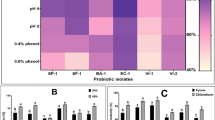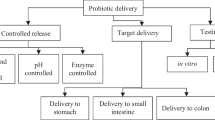Abstract
This study aimed to determine the survival and antibacterial activity of Lactobacillus plantarum TISTR1465 encapsulated with Eleutherine americana oligosaccharide extract. Capsules were stored at 4 °C for 0, 2, and 4 weeks. The encapsulated cells were evaluated for their survival after sequential exposure to simulated gastric and intestinal juices, then evaluated in terms of their antibacterial activity. Survival of the encapsulated cells was higher than that of free cells at weeks 2 and 4. Highest levels of viable cells were observed with encapsulation in E. americana oligosaccharide extract. No surviving free cells were found in week 4. Yoghurt prepared with encapsulated cells showed less acidification than with free cells. Antibacterial activity of L. plantarum TISTR1465 before pH neutralisation against Clostridium perfringens ATCC13124, Staphylococcus aureus ATCC 25923, Escherichia coli ATCC 25922, and Salmonella Typhimurium ATCC13311 was higher than after pH neutralisation. Encapsulation by extrusion enhanced antibacterial activity of the cells against enteropathogenic bacteria. The antibacterial activity of encapsulated cells against Gram-positive bacteria was higher than that against Gram-negative bacteria. Results indicates that L. plantarum TISTR1465 encapsulated with E. americana oligosaccharide extract showed potential for application as a functional food additive.



Similar content being viewed by others
References
Stanton C, Ross RP, Fitzgerald GF, Sinderen DV (2005) Fermented functional foods based on probiotics and their biogenic metabolites. Curr Opin Biotechnol 16:198–203
Food and Agriculture Organization of the United Nations and World Health Organization Report (2001) Evaluation of health and nutritional properties of probiotics in food including powdered milk with live lactic acid bacteria. http://www.fao.org/es/esn/probio/probio.htm; Accessed 15.08.15
Shah NP (2007) Functional cultures and health benefits. Int Dairy J 17:1262–1277
Li C, Wang CL, Sun Y, Li AL, Liu F, Meng XC (2016) Encapsulation of Lactobacillus rhamnosus GG by transglutaminase cross-linked soy protein isolate to improve survival in simulated gastrointestinal conditions and yoghurt. J Food Sci 81(7):M1726–MM734
Shoji AS, Oliveira A, Balieiro JC et al (2013) Viability of Lactobacillus acidophilus capsules and their application to buffalo milk yoghurt. Food Bioprod Process 91(2):83–88
Amine KM, Campagne CP, Raymond Y et al (2014) Survival of microencapsulated Bifidobacterium longum in cheddar cheese during production and storage. Food Control 37:193–199
Rodriguez-Huezo ME, Estrada-Fernandez AG, Garia-Almendarez BE et al (2014) Viability of Lactobacillus plantarum entrapped in double emulsion during Oaxaca cheese manufacture, melting and simulated intestinal conditions. LWT Food Sci Technol 59(2):768–773
Nazzaro F, Fratianni F, Coppola R, Sada A, Orlando P (2009) Fermentative ability of alginate-prebiotic encapsulated Lactobacillus acidophilus and survival under simulated gastrointestinal conditions. J Funct Foods 1:319–323
Gibson GR, Probert HM, Van Loo J, Rastall RA, Roberfroid MB (2004) Dietary modulation of the human colonic microbiota: updating the concept of prebiotics. Nutr Res Rev 17:259–275
Phoem AN, Voravuthikunchai SP (2013) Eleutherine americana as a growth promotor for infant intestinal microbiota. Anaerobe 20:14–19
Ifesan BOT, Siripongvutikorn S, Hutadilok TN, Voravuthikunchai SP (2009) Evaluation of the ability of Eleutherine americana crude extract as natural food additive in cooked pork. J Food Sci 74(7):M352–M357
Ifesan BOT, Siripongvutikorn S, Voravuthikunchai SP (2009) Application of Eleutherine americana crude extract in homemade salad dressing. J Food Prot 72:650–655
Phoem AN, Chanthachum S, Voravuthikunchai SP (2015) Preparation of Eleutherine americana-alginate complex capsules and application in Bifidobacterium longum. Nutrients 7:831–848
Phoem AN, Chanthachum S, Voravuthikunchai SP (2015) Applications of microencapsulated Bifidobacterium longum with Eleutherine americana in fresh milk tofu and pineapple juice. Nutrients 7:2469–2484
Krasaekoopt W, Watcharapoka S (2014) Effect of addition of inulin and galactooligosaccharides on the survival of microencapsulated probiotics in alginate beads coated with chitosan in simulated digestive system, yogurt and fruit juice. LWT Food Sci Technol 57(2):761–766
Ribeiro MC, Chaves KS, Gebara C, Infante FNS, Grosso CRF, Gigante ML (2014) Effect of encapsulation of Lactobacillus acidophilus LA-5 on physicochemical, sensory and microbiological characteristics of stirred probiotic yoghurt. Food Res Int 66:424–431
Pinto SS, Fritzen-Freire CB, Munoz IB, Prudencio ES, Amboni RD (2012) Effects of the addition of microencapsulated Bifidobacterium BB-12 on the properties of frozen yogurt. J Food Eng 111(4):563–569
Brachkova MI, Duarte MA, Pinto JF (2010) Preservation of viability and antibacterial activity of Lactobacillus spp. in calcium alginate beads. Eur J Pharm Sci 41(5):589–596
Trabelsi I, Ayadi D, Bejar W, Bejar S, Chouayekh H, Ben Salah R (2014) Effects of Lactobacillus plantarum immobilization in alginate coated with chitosan and gelatin on antibacterial activity. Int Bio Macromole 64:84–89
Krasaekoopt W, Bhandari B, Deeth H (2004) The influence of coating materials on some properties of alginate beads and survivability of microencapsulated probiotic bacteria. Int Dairy J 14:737–743
Chavarri M, Maranon I, Ares R, Ibanez FC, Marzo F, Villaran MDC (2011) Encapsulation of a probiotic and prebiotic in alginate-chitosan capsules improves survival in simulated gastro-intestinal conditions. Int J Food Microbiol 142:185–189
Rao A, Shiwnarain N, Maharaj I (1989) Survival of microencapsulated Bifidobacterium pseudolongum in simulated gastric and intestinal juices. Can Inst Food Sci Technol 22:345–349
Bourne MC (2002) Food texture and viscosity: concept and measurement, 2nd edn. Academic Press, New York Texture, viscosity, and food
Sandoval-Castilla O, Lobato-Calleros C, Garcia-Galindo HS, Alvarez-Ramirez J, Vernon-Carter EJ (2010) Textural properties of alginate-pectin beads and survivability of entrapped Lactobacillus casei in simulated gastrointestinal conditions and in yoghurt. Food Res Int 43:111–117
Kailasapathy K (2006) Survival of free and encapsulated probiotic bacteria and their effect on the sensory properties of yoghurt. LWT Food Sci Technol 39:1221–1227
Ranadheera CS, Evans CA, Adams MC, Baines SK (2012) Probiotic viability and physic-chemical and sensory properties of plain and stirred fruit yoghurts made from goat’s milk. Food Chem 135:1411–1418
Holdeman LV, WEC M (1977) Anaerobe laboratory manual. Virginia Polytechnic Institute and State University, Blacksburg 132 pp
Brinques GB, Ayub MAZ (2011) Effect of encapsulation on survival of Lactobacillus plantarum in simulated gastrointestinal conditions, refrigeration, and yogurt. J Food Eng 103:123–128
Tejero-Sariñena S, Barlow J, Costabile A, Gibson GR, Rowland I (2012) In vitro evaluation of the antimicrobial activity of a range of probiotics against pathogens: evidence for the effects of organic acids. Anaerobe 18(5):530–538
Schoster A, Kokotovic B, Permin A, Pedersen PD, Bello FD, Guardabassi L (2013) In vitro inhibition of Clostridium difficile and Clostridium perfringens by commercial probiotic strains. Anaerobe 20:36–41
Zhao M, Qu F, Wu Z, Nishinari K, Phillips GO, Fang Y (2017) Protection mechanism of alginate capsules with different mechanical strength for Lactobacillus plantarum ST-III. Food Hydrocoll 66:396–402
Shi LE, Li Z, Li D, Xu M, Chen H, Zhang Z (2013) Encapsulation of Lactobacillus bulgaricus in carrageenan-locust bean gum coated milk microspheres with double layer structure. LWT Food Sci Technol 54(1):147–151
Chandramouli V, Kailasapathy K, Peiris P, Jones M (2004) An improved method of encapsulation and its evaluation to protect Lactobacillus spp. in simulated gastric conditions. J Microbiol Methods 56(1):27–35
Etchepare MDA, Raddatz GC, Moraes Flores EMD et al (2016) Effect of resistant starch and chitosan on the survival of Lactobacillus acidophilus microencapsulated with sodium alginate. LWT Food Sci Technol 65:511–517
Argin S, Kofinas P, LoY M (2014) The cell release kinetics and swelling behavior of physically crosslinked xanthan-chitosan hydrogels in simulated gastrointestinal conditions. Food Hydrocoll 40:138–144
Darjani P, Nezhad MH, Kadkhodaee R, Milani E (2016) Influence of prebiotic and coating materials on morphology and survival of a probiotic strain of Lactobacillus casei exposed to simulated gastrointestinal conditions. LWT Food Sci Technol 73:162–167
Homayouni A, Azizi A, Ehsani MR, Yarmand MS, Razavi SH (2008) Effect of microencapsulation and resistant starch on the probiotic survival and sensory properties of synbiotic ice cream. Food Chem 111:50–55
Corcoran B, Stanton C, Fitzgerald G, Ross R (2008) Life under stress: the probiotic stress response and how it may be manipulated. Curr Pharm Des 14:1382–1399
Dave RI, Shah NP (1997) Viability of yoghurt and probiotic bacteria in yoghurts made from commercial starter cultures. Int Dairy J 7(1):31–41
Ma J, Qi WT, Yang LN, Yu WT, Xie YB, Wang W, Ma XJ, Xu F, Sun LX (2007) Microcalorimetric study on the growth and metabolism of microencapsulated microbial cell culture. J Microbiol Methods 68:172–177
Zhao M, Qu F, Cai S, Fang Y, Nishinari K, Phillips GO (2015) Encapsulation of Lactobacillus acidophilus CGMCC1.2686 correlation between bacteria survivability and physical properties of capsules. Food Biophys 10(3):292–299
Acknowledgments
We thank Natural Product Research Center of Excellence, Prince of Songkla University, for providing E. americana oligosaccharide extract. We acknowledge Peter Charge, George William Gibson, and Associate Professor Dr. Seppo Karrila for assistance with manuscript preparation.
Funding
This research has been supported by Research Fund of Songkhla Rajabhat University, Fiscal Year 2016.
Author information
Authors and Affiliations
Corresponding author
Ethics declarations
Conflict of interest
The authors declare that they have no conflict of interest.
Additional information
Responsible Editor: Susana Saad
Publisher’s Note
Springer Nature remains neutral with regard to jurisdictional claims in published maps and institutional affiliations.
Rights and permissions
About this article
Cite this article
Phoem, A.N., Mayiding, A., Saedeh, F. et al. Evaluation of Lactobacillus plantarum encapsulated with Eleutherine americana oligosaccharide extract as food additive in yoghurt. Braz J Microbiol 50, 237–246 (2019). https://doi.org/10.1007/s42770-018-0017-2
Received:
Accepted:
Published:
Issue Date:
DOI: https://doi.org/10.1007/s42770-018-0017-2




